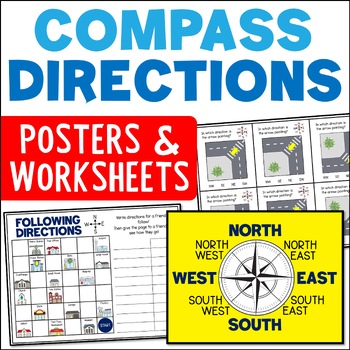Directional Terms Compass Posters & Ordinal & Cardinal Directions Worksheets
- PDF
- Easel Activity
Description
Do your students need help with learning directional terms and following directions? These compass rose posters and ordinal and cardinal directions worksheets included can help! The range of compass direction activities include cut and paste compass roses, task cards, and town map activities. This is a great resource for Grades 2 and 3.
Learning about the compass rose and ordinal and cardinal directions is an important skill for students. It opens up the chance for lots of fun and engaging mapping lessons and orienteering lessons. Knowing directions also helps students navigate the world in everyday life.
Here is what is included…
Five compass rose posters
- Each one has different levels of details. One has just the initials of the four cardinal points. Another has the four cardinal points with their full names. Another has the cardinal points written as a mnemonic. And finally, one has the four cardinal points and four ordinal points on it. Each one comes in color and b/w
A sheet of visuals for each of the posters
- These are mini versions of the posters so that students can have a small visual they can keep at their desk to refer to.
Two cut and paste compass rose worksheets
- One has just cardinal directions and the other has both cardinal and ordinal directions. Students cut out the directions and paste them in the correct locations.
Two sheets of task cards
- They each require students to identify the directions arrows are pointing. One is for cardinal directions and the other is for ordinal directions.
A following directions worksheet
- Students follow directions to navigate around a city map and record where each step of directions takes them to.
A creating directions worksheet
- Students write directions around a city map for a partner to follow and record where each direction takes them to.
Solution Pages
To See More
Click on the Preview button above to take a closer look at everything included!
How They Can Be Used
- The posters can be displayed on the classroom wall. They can be switched out as needed. For example, when the class learn about ordinal directions then that poster can be put on display. Teachers can use the language of the compass rose directions throughout the day and students can refer to the posters when needed.
- Students can keep one of the miniature poster visuals with them at their desks so they can have it handy to refer to as needed.
- The cut and paste compass worksheets can be a great way for students to apply the knowledge of compass directions they have learned.
- The following directions worksheet can be done by students in pairs or on their own. It would make a good assessment task for students to show their knowledge of the compass rose directions.
- The creating directions task is a great way for students to apply their knowledge through creating directions for a classmate to follow.
Students will enjoy the tasks included in this resource and the posters and mini-poster visuals will provide a level of support for them that will help them to be successful. Teachers will appreciate the no prep visuals and activities and will be able to focus on assisting students.
You may be interested in these other resources
Country Report Projects BUNDLE for EVERY Country in EVERY Continent
Continent Map Activity NORTH AMERICA - 4 Different Puzzles
USA States Reports - Research Projects - US Geography
Australian Geography Bundle - States, Maps, Puzzles, Research and Animals
For Savings and Benefits
⇨ Follow my store to be notified of new products. New products are 50% off for the first 24 hours!
⇨ Leave a review on purchased products to earn points towards free TpT purchases!
Copyright © Ben Lukis
Permission to copy for single classroom use only.
Please purchase additional licenses if you intend to share this product






